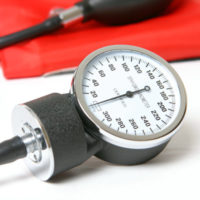The Dangers of High Blood Pressure
December 19, 2019 Having high blood pressure is not uncommon – but the complications it can cause range from mild to fatal. The American Heart Association (AHA) reports that nearly half of Americans have high blood pressure, a condition in which the force of blood flowing through a person’s blood vessels is consistently too high. If you have high blood pressure or are at risk for developing it, there are plenty of helpful steps you can take to effectively manage the condition and its associated risks.
Having high blood pressure is not uncommon – but the complications it can cause range from mild to fatal. The American Heart Association (AHA) reports that nearly half of Americans have high blood pressure, a condition in which the force of blood flowing through a person’s blood vessels is consistently too high. If you have high blood pressure or are at risk for developing it, there are plenty of helpful steps you can take to effectively manage the condition and its associated risks.
What Blood Pressure Readings Mean
Not too long ago, the AHA released new guidelines for what it considers high blood pressure. Altogether there are five blood pressure categories: normal, elevated, hypertension stage 1, hypertension stage 2, and hypertensive crisis. Blood pressure readings are expressed in two numbers – a top number, which is the systolic pressure, and a bottom number, or the diastolic measurement.
Systolic pressure refers to the amount of pressure in a person’s arteries when the heart muscle contracts. Diastolic pressure is a measurement of a person’s blood pressure when the heart muscle is in between beats. When a person has high blood pressure, it means that his or her heart is working too hard to pump blood throughout the body. High blood pressure can result in a variety of serious and deadly complications like stroke, heart attack, and many other life threatening cardiac conditions.
The Five Blood Pressure Categories
There are different numerical cut-offs for each of the five blood pressure categories. Here is a brief overview of the AHA’s categories:
- Normal: systolic below 120 and diastolic below 80,
- Elevated: systolic 120-129, diastolic below 80,
- Hypertensive stage 1: systolic 130-139, diastolic 80-89,
- Hypertensive stage 2: systolic 140 or higher, diastolic 90 or higher, and:
- Hypertensive crisis*: Systolic reading above 180 and diastolic is greater than 120
*If you are receiving a hypertensive crisis reading and are not under the immediate care of a physician, please consult a medical professional right away.
The “Silent Killer”: Who is at Risk and the Symptom Myths
High blood pressure is often referred to as a “silent killer”. This is because many people do not know they have high blood pressure and most of the time, there are no obvious symptoms that accompany it. In fact, there are many myths surrounding high blood pressure and its supposed “symptoms”, like headaches and nosebleeds.
Data shows that nosebleeds and headaches are rarely ever caused by HBP, except for in the case of a hypertensive crisis. Some people also assert that high blood pressure causes nervousness, difficulty sleeping, facial flushing, and sweating – but the AHA says these symptoms far too frequently result from other conditions – not cases of high blood pressure. The only effective way to find out if you have high blood pressure is to get checked out by a licensed and trained medical professional.
Certain factors do increase a person’s chances for developing high blood pressure, however. These factors include:
- Family history, such as if parents or other close blood relatives have high blood pressure,
- Having chronic kidney disease, or CKD
- Gender: men are more likely to have high blood pressure before the age of 65. After 65-years-old, women are more likely to develop HBP, and:
- African-Americans face the highest risks for developing HBP – and they are also more likely to experience severe complications.
Some risk factors are unchangeable, while others are not. Modifiable risk factors for high blood pressure include a lack of physical activity or exercise, smoking, maintaining an unhealthy diet (especially one high in sodium), heavy alcohol use, having high cholesterol, being obese, and/or having diabetes. If you are interested in making some healthy lifestyle changes, there is no better time than now. Have an honest conversation with your doctor today.
Remember the age-old adage: “an ounce of prevention is worth a pound of cure” – every small step a person takes in improving his or her heart health can help them live a longer and healthier life. If you have questions about being diagnosed or misdiagnosed with high blood pressure or became ill during the course of your treatment due to a healthcare provider’s negligence, please contact a representative at our firm directly. We can help.
Philadelphia Medical Malpractice Lawyers at Galfand Berger, LLP Representing Injured Individuals Since 1947
If you were injured as a result of a healthcare provider’s negligence, please contact our Philadelphia medical malpractice attorneys.Galfand Berger has offices located in Philadelphia, Bethlehem, Lancaster, and Reading we serve clients throughout Pennsylvania and New Jersey. To schedule a consultation, call us at 800-222-8792 or complete our online contact form.
 Google Screened
Google Screened
